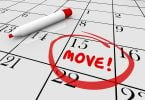Broken dishes scratched furniture, lost boxes and dented TVs- there really is quite a lot to worry about when it comes to moving. But your belongings aren’t the only thing that is subject to damage during a move. The good news is most damage can be repaired without having to call in (and spend on) a professional. Whether you’re concerned about getting your security deposit back or wanting your new home to look its best, some basic DIY home repair know-how can come in very handy.
How to Fix Damage to the Walls:
- Fixing Holes
Even if your home hasn’t suffered any significant damage, its walls are probably showing signs of normal wear and tear which are easy to fix. Anything that was mounted on the wall has probably left a small hole, and most landlords expect this kind of an eyesore to be fixed before giving back the security deposit. Luckily, it is very easy to fix these holes- all you need is some spackle and sandpaper. After your full-service movers have taken down your gallery wall simply apply the spackle to the holes with a putty knife, wait for it to dry and then sand it down until the surface is smooth. For larger holes, the process is slightly more complicated. You will need to fill out the hole with a mesh repair patch or a plaster patch before applying spackle and sanding it down. Check out this video to learn more about repairing drywall, and this one if you have a plaster wall to fix. - Removing Scuff Marks
Scuff marks are stains caused by color transferring from your furniture onto the wall. While they probably won’t cost you your deposit they can make the house appear to be dirty and not well cared for. Scuff marks are easily removed with a magic eraser- simply soak the eraser in water, squeeze it out so that it doesn’t drip and apply with some pressure to the stains. Finish the job by drying the wall off with a clean towel. If you can’t find a magic eraser, an all-purpose cleaner will do just fine, though you might need to put in a little bit more elbow grease. - Fixing Scratches on hardwood floors
Floors are likely to be damaged during a move because heavy objects are being moved around, picked up and put down, which may lead to dents and scratches. Obviously, it’s better to protect hardwood floors than to fix them later. If some damage does incur, don’t worry- most scratches can be fixed quite easily. Start by applying fine thin wool to the scratch, remembering to go along the grain of the wood to prevent more damage. Then apply pre-mixed wood filler to the scratch and wait for it to dry off completely. Then sand the excess filler down and apply a varnish that matches the color of your floor. Check out this video guide to see how it’s done. - Fixing scratches on ceramic tiles
Some damage to ceramic tiles, like deep scratches and dents, can only be fixed by replacing the tile. Light scratches on the other hand, can be fixed relatively easily, using a surprising household item- toothpaste! Make sure your tiles are clean and dry before applying the toothpaste using a soft cloth. Vinegar or brass polisher will also do the trick. Seal the area with some car wax and bam! Good as new. You could also fix scratches with nail polish- check out this creative video tutorial to find out how.
How to fix damage to carpeting:
- Stain Removal
There are a number of cleaning materials you can use to remove stains from your carpeting, including baking soda, acetone, ammonia and rubbing alcohol- depending on the cause of the stain. This video shows just how to use each of these detergents in great detail.For more stubborn stains, consider renting a heavy duty carpet cleaning machine- it is similar to a vacuum cleaner but also uses a cleaning agent. This might sound pricey but chances are it will cost less than your security deposit. - Fixing a displaced carpet
If your carpet has been pulled out of its metal threshold you will need to reattach it by removing the old threshold, putting in a new one and attaching the old carpet to it. If the carpet has started to fray you might need to replace the patch of carpet, but as long as the damage doesn’t extend over one inch your repair should be quite aesthetic. - Patching a damaged spot
In some cases, you will need to cut out the damaged part of the rug and replace it with a plug. It’s best to use remnants of the original carpeting, but if you don’t have any of those you can “borrow” a piece from an inconspicuous area of the carpet, like under a piece of furniture that isn’t going to be moving anytime soon. Make sure to cut and place the plug and the damaged piece so that their naps are running in the same direction. This video demonstrates very clearly how to do this.








